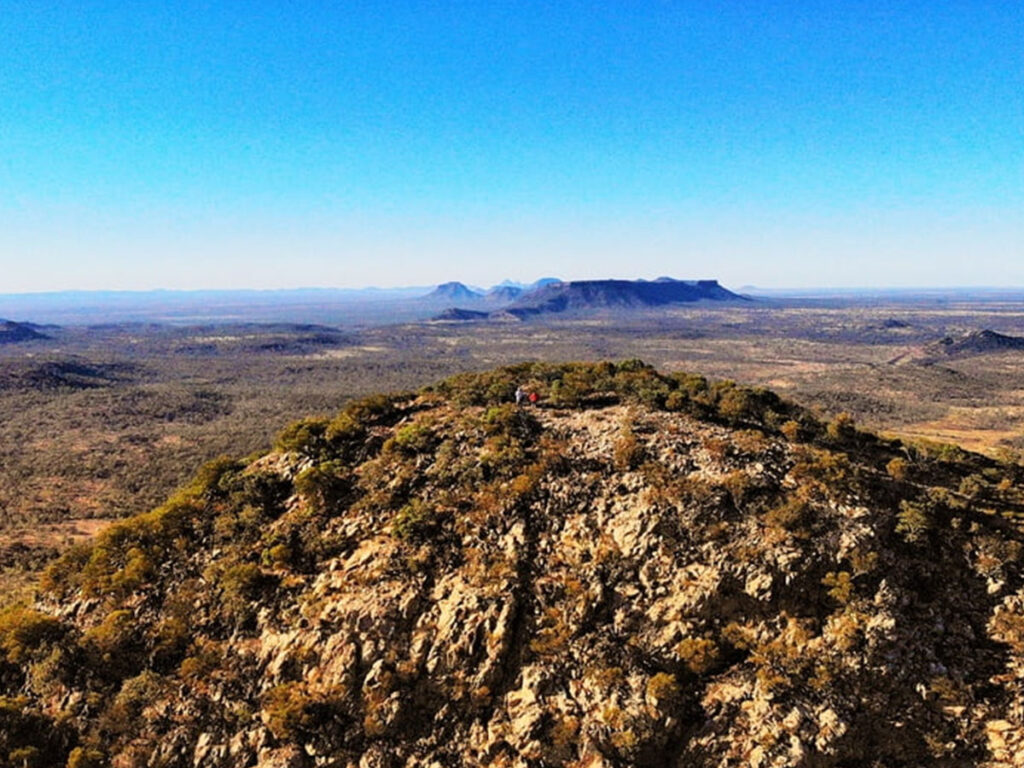Written by Damien Burrows
To the immediate south of Townsville are one of the most significant coastal wetland aggregations in Australia. In fact, the Bowling Green Bay coastal wetlands are 1 of only 6 wetlands in Qld listed under the international Ramsar wetlands convention. Fortunately, there are some small hills within this extensive wetland system that provide an aerial view across these landscapes. Feltham Cone (also known as Mt Burrumbush) is the largest of these. At 279m high, Feltham Cone, part of Bowling Green Bay National Park, is just 7m shorter than Castle Hill. It is a prominent feature off the coastal side of the Bruce Highway a few km south of the AIMS-Cungulla turnoff. Feltham Cone is surrounded by freshwater and saline wetlands in all directions. The promise of elevated and unimpeded wetland views from a modest hike and elevation gain, was a great choice for a half-day birthday hike for Townsville Hike and Explore founder Michael Pugh.

Just after sunrise, 14 of us found ourselves dodging wetland patches to the reach the base of the cone. There are no trails on the cone, but the vegetation is sparse enough to easily navigate your own path – just wear gaiters and long pants to avoid grass cuts. The flanks of the cone are generously endowed with my favourite hiking surface – sloping granite rockfaces, allowing regular clear views and easier walking. Within a short altitude gain, we were standing on a perched boulder photographing across the Haughton floodplain with the Giru sugar mill in the distance to the south, and the Haughton River mouth visible to the east. Another 50m higher, navigating across another large sloping rockface, we were seeing across shallow saline lakes and smaller hills (incl. The Cone @94m alt.) looking north toward Chunda Bay and Cape Cleveland, and shortly after that, looking across mangroves and mudflats west to cloud-topped Mt Elliot.
Whilst the views are varietous, the walk itself is also rewarding. Unusual rock formations abound; granite boulders covered with interesting patterns of pink and pale green lichens are common. We even found two mysterious deep holes near the summit, one of which we couldn’t see the bottom of. Numerous native kapok trees (Cochlospermum gillivraei), which favour rocky hillsides, were in full bloom in many locations. These trees shed their leaves in winter, just before flowering. The profusion of large, vibrant yellow flowers on bare trees denuded of all their foliage, set against sparsely vegetated rockscapes, provided a captivating scene that had some testing their nature photography skills.




We traversed Feltham Cone for an hour before reaching the summit. Just below the summit, we were reminded of previous human visitors when we found a metal (survey) pole with a (unfortunately) perished note left in a glass bottle. We recorded the names and date of our party on fresh paper and replaced the bottle for future explorers who may summit this little known gem. Feltham Cone is also known to contain aboriginal rock art, as are many rocky sites in this area, but with some having afternoon commitments, we lacked the time to search for these. One can readily imagine the abundance of resources provided by the wetlands and other diverse habitats here. We discussed James Morrill, the 22yr-old seaman shipwrecked in this area in 1846. Reaching the shore of Cape Cleveland after 42 days floating at sea, he was rescued by the local aboriginal tribe around Mt Elliot and lived with them for 17 years. Surely, he had walked upon Feltham Cone many times, and gazed upon these views.




At the summit, we enjoyed home-made tea cake, nut slice and brownies in honor of Michael’s birthday, a rare treat on bushwalks. On the descent, we followed a dry, partly shady creekline that added to the botanical and geological diversity of the walk.
Overall, it was a splendid half day shared with friends, and a fitting way to mark Michael’s birthday, visiting yet another worthy but unheralded local destination. Long may our future drives down the Bruce Highway, looking east across the wetlands, bring back the memories.






